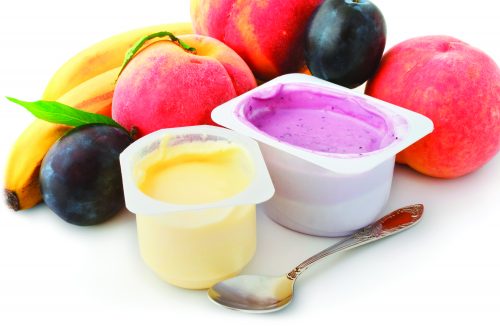
HFG senior nutritionist Rose Carr explores the production of common foods.
Yoghurt is fermented milk and it has been made for thousands of years. In the days before refrigeration or heat treatments were available, milk was naturally soured to produce different cultured or fermented milk products.
Fermented milk products, including yoghurt, sour cream, buttermilk and crème fraîche, are produced by introducing microorganisms which ferment the milk. During fermentation, the milk becomes more acidic and coagulates so as well as increasing its shelf life, the taste and texture change.
Yoghurt is a specific type of fermented milk where the fermentation is carried out by microorganisms which convert lactose, the natural sugar in milk, into lactic acid.
Yoghurt production
Milk used for yoghurt production is prepared in the same way as the milk we drink. It is pasteurised to kill any harmful bacteria the raw milk could contain, and homogenised to break down the fat particles and mix them evenly through the milk.
The type of milk used will depend on the type of yoghurt being made, so low-fat milk is used to produce low-fat yoghurt. Milk solids, such as skim milk powder, are added to the milk to enhance the body and texture of the yoghurt.
The milk is then ‘inoculated’ with the starter culture of bacteria, which means the bacteria is added to the milk at a concentration of around one to three per cent. Lactobacillus bulgaricus and Streptococcus thermophilus are commonly used in yoghurt production, although bacteria such as Lactobacillus acidophilus, L. bifidus, L. subsp. casei and others may be added as probiotic cultures. The bacteria need a warm temperature to operate in so the milk is held at around 40-43°C while the fermentation progresses, which usually takes several hours.
Milk starts with a pH of around 6.7. The pH is the measure of the level of acidity or alkalinity in a liquid (water is neutral with a pH of 7). The pH of milk will decline (become more acidic) during fermentation, as most of the lactose is converted to lactic acid. The product is cooled to stop fermentation once the pH reaches around 4.5. At this point the texture and flavour will have changed and the milk has become yoghurt.
Many other ingredients may be added to yoghurt:
- sweeteners, such as sugar, honey or low-energy sweeteners
- fruit, fruit pastes or fruit juices may be added for flavour and sweetness
- stabilisers, such as pectins, gums or gelatins, may be added to improve the texture or to prevent separation
- fibre, such as inulin or polydextrose, which also add sweetness and act as food for probiotic bacteria (that is they are prebiotic)
- vitamins
- flavours and colours
- probiotic cultures.
Probiotics
Probiotic cultures are live microorganisms that provide health benefits when we take them in adequate amounts over a period of time. Often called friendly or good bacteria, probiotics help maintain a healthy balance of bacteria in the gut. However, probiotics are not all the same. Some specific strains of probiotic bacteria have been shown to have a positive effect on different aspects of health such as gut function, immunity, or allergies. However, they need to be available in a therapeutic quantity to have the effect. There are also many strains of bacteria for which there is no evidence of any specific health benefit.
Use of the term ‘probiotic’ is not regulated, so we often see yoghurt containing, for example Lactobacillus acidophilus, labelled as probiotic. In reality, while it won’t do you any harm, the scientific evidence for any specific benefit for Lactobacillus acidophilus and gut health is still unclear, and generally these yoghurts do not state the amount of live bacteria they contain and relate that to a beneficial dose. If packaging doesn’t make a specific claim and back it up with evidence of the effectiveness or the probiotic there is unlikely to be a benefit.
If yoghurt claims to be probiotic, we want to know there is published scientific evidence supporting the claimed benefit of the specific probiotic strain when it is used in the recommended serving size. As the number of probiotic bacteria declines over time and with exposure to heat, we also want to know that the yoghurt delivers the required amount of probiotics up to the ‘best before’ date when stored as directed.
Lactose intolerance
Lactose, the sugar that occurs naturally in milk, is digested by an enzyme called lactase. Some people are lactose intolerant as they do not make the lactase enzyme and they need to minimise lactose in their diets. People who are lactose-intolerant may be more able to digest yoghurt as it contains less lactose than milk, although it should be noted the amount of lactose in yoghurt can vary widely.
Making yoghurt at home
Making your own yoghurt is very simple. Years ago, we used to mix one spoonful of yoghurt from the fridge with a bowl of warm milk, let it ferment in the hot water cupboard overnight, and by morning we would have yoghurt. It then went into the fridge and before it was finished the last few tablespoons were used as the starter for the next batch.
These days a cheap yoghurt-maker makes the job easier, especially if you don’t have a hot water cupboard (or the desire to put your yoghurt in it). We can buy a wide variety of styles and flavours of yoghurt starters in sachets and all we need to do is add hot water.
Did you know?
- Yoghurt is an important ingredient in both Middle Eastern and Indian cuisine.
- Although most of the yoghurt we eat is made from cow’s milk, yoghurt is also made from the milk of sheep, goats and buffalo.
- Traditional Greek yoghurt is strained through a cloth, such as muslin, which removes excess moisture and leaves a thick, creamy texture.
- Most cow’s milk yoghurt will easily curdle when used in cooking, but can be stabilised with the addition of a little cornflour, although Greek-style yoghurts are suitable for cooking.
www.healthyfood.com










